In the 50 years since President Lyndon B. Johnson declared the War on Poverty, our nation’s system of work and income supports has protected millions of families from poverty, mitigated hardship, and promoted economic opportunity. For example:
- The Supplemental Nutrition Assistance Program, or SNAP, kept nearly 5 million people out of poverty last year and has all but ended extreme hunger in the United States.
- Medicaid is a pillar of our health care system, particularly for children, low-income parents, and people with disabilities, and has dramatically lowered the rate of the uninsured.
- Head Start has helped nearly 30 million children since its inception by promoting school readiness and offering comprehensive health services.
These and other vital programs have also acted as important buffers during recessions. In addition to helping families weather periods of job loss, these programs promote economic recovery during periods of high unemployment and ensure that households don’t cut back on their spending to such a degree that even more workers lose their jobs.
Yet much has changed in the past 50 years. Demographic shifts, insufficient access to jobs that pay decent wages, and an economy that increasingly serves only the wealthiest among us pose a new set of challenges. Moreover, several components of our system of work and income supports have grown weaker over time, and today too few individuals and families get the help they need and deserve in hard times. Given that fully four out of five Americans will experience at least one year of significant economic insecurity at some point during their working years—and half will experience three years or more—we should all be invested in ensuring that our social contract provides adequate protection amid the ups and downs of life.
An economy that’s only working for the wealthy few
The late 1970s saw the end of shared economic growth. In the decades since, those at the very top of the income ladder have enjoyed huge gains, whereas most Americans have seen their wages stagnate amid rising costs. The bottom 20 percent of families saw their incomes decline by 7.4 percent in real terms between 1979 and 2009, while the top 5 percent saw their real incomes rise by 72.7 percent. In the wake of the Great Recession, the top 5 percent of families have resumed real income growth—with the richest 1 percent capturing 95 percent of real income growth between 2009 and 2012—while low- and middle-income Americans have watched their incomes continue to fall in real terms despite four years of economic growth.
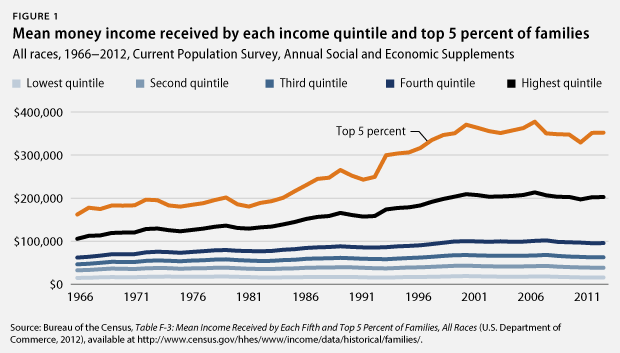
Not enough jobs with decent wages
As the gap has widened between those at the top of the income ladder and the majority of Americans, the minimum wage has lost 30 percent of its real value since 1968, despite tremendous gains in productivity. Had the minimum wage been indexed to inflation in 1968, it would be more than $10 per hour today. This erosion in the value of the minimum wage means that it is no longer sufficient to provide a decent standard of living—or even to lift a worker with two children out of poverty.
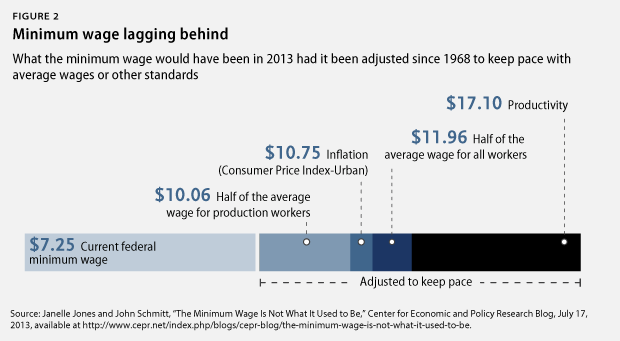
High school diploma no longer enough
During this same period, the job prospects and earning potential of male workers with a high school diploma have dropped substantially. The employment rate of non-Hispanic white and African American males who graduated high school fell from 96 percent in 1970 to just 75 percent in 2011. Earnings for these groups dropped by more than 50 percent during the same period.

Families relying on mothers’ wages
At the same time as men’s wages have declined, families are increasingly relying on mothers as breadwinners. Today—in just over 4 out of 10 families—mothers provide more than half of their families’ earnings. In nearly two-thirds of families, mothers provide a quarter or more of their families’ earnings, compared with 27 percent in 1969. Women increasingly play dual roles as caregivers and breadwinners, yet most lack basic workplace protections such as equal pay, paid sick days, and paid leave, as well as affordable, high-quality child care. Just one in six eligible families receives child care assistance. Women are also more likely to work in poorly compensated jobs than men. For example, nearly two-thirds—about 62 percent—of workers in jobs that pay the minimum wage or less are women.
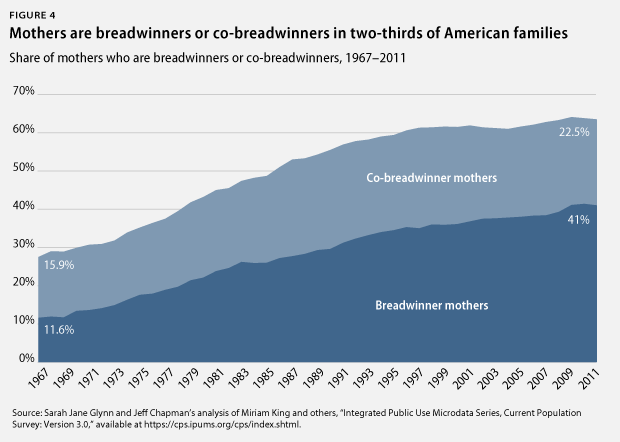
Struggling families falling through the cracks
Unfortunately, our safety net has in many ways failed to keep pace with the 21st century realities of our changing economy and these demographic shifts. While our system of work and income supports does a tremendous amount to increase opportunity and mitigate hardship, several components have been cut back and are now less effective, leaving far too many struggling individuals and families with little to fall back on in hard times. One important example is unemployment insurance: After Congress failed to renew emergency unemployment compensation earlier this year, the share of unemployed workers receiving jobless benefits dropped to 31.7 percent, almost the lowest on record.
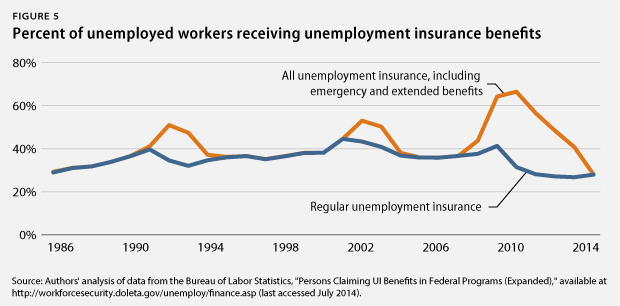
Another important example is income assistance for families with children. In 1996, Aid to Families with Dependent Children—initially created as part of Social Security in 1935—was eliminated and replaced with a flat-funded block grant to states known as Temporary Assistance for Needy Families, or TANF. Funding for TANF has been frozen for nearly two decades, without even routine increases to keep pace with inflation or population growth. Not surprisingly, the program has fared poorly as a tool for mitigating hardship—just one-third of poor families with children are helped by TANF, compared to more than 80 percent in 1996. In more than half of all states, fewer than one in five families with incomes below the federal poverty line receive TANF. The program has also proven woefully unresponsive to recessions. While the number of low-income households receiving SNAP rose significantly during the Great Recession, as one would expect given the tremendous increase in need, the number of families receiving income support and re-employment assistance through TANF barely budged during the same period, and actually declined in some states.

Struggling families increasingly turning to high-cost credit as their safety net
As wages have lost real value over time, fewer families have savings to fall back on in hard times. About two in five Americans report that they “probably” or “certainly” would not be able to come up with $2,000 in 30 days in the event of an emergency—a figure that rises to two-thirds when it comes to lower-income Americans. Families appear to be turning to payday loans and other forms of high-cost credit to make ends meet when times get tight, which often kicks off a downward spiral of debt and hardship.
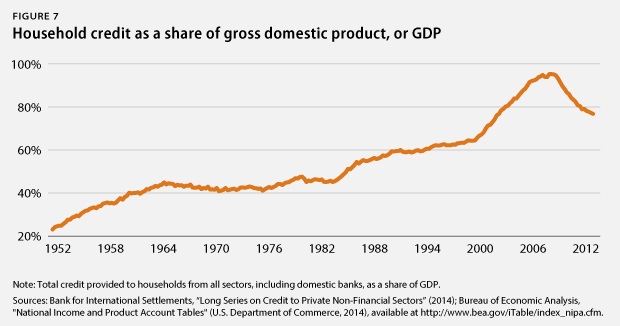
Family caregivers feeling the squeeze
Finally, as the Baby Boom generation ages into their years of needing care and more women enter the paid workforce, one in six working Americans today provide care for an elderly or disabled family member, relative, or friend. This figure is all but certain to rise as the Baby Boom generation ages further. By 2050, the share of the U.S. population that is 65 or older is expected to top one-fifth of all Americans, compared to 13 percent today.

Conclusion
Our country—and the challenges families face—have changed. To build an economy that works for all Americans, not just the wealthy few, we need to take account of these changes and update our social contract to reflect 21st century realities. In addition to common-sense policies to grow and support a strong middle class—such as raising the minimum wage, ensuring access to paid leave and paid sick days, and universal pre-K—a robust and responsive system of work and income supports is essential to protect against what President Franklin D. Roosevelt called the “hazards and vicissitudes of life.”
Author’s note: In the months to come, the Center for American Progress’ Poverty to Prosperity team will be exploring policy solutions to strengthen and modernize our nation’s safety net to reflect 21st century realities, and to better facilitate economic mobility for families on the brink.
Rebecca Vallas is the Associate Director of the Poverty to Prosperity Program at the Center for American Progress. Shawn Fremstad is a Senior Fellow at the Center. Melissa Boteach is the Vice President of Half in Ten and the Poverty to Prosperity Program at the Center.